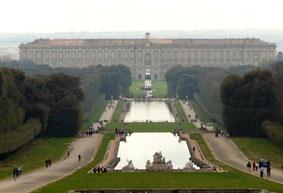


All the structures

Caserta is a province in Campania with nearly 80,000 inhabitants.
The area around Caserta, known as the Piana del Volturno, is dominated by the eighteenth-century palace, which has brought fame to the whole area.
UNESCO has proclaimed The Palace of Caserta a World Heritage site.
At Santa Maria Capua Vetere one can admire the magnificent Campania amphitheatre. Experts have discovered that the amphitheatre’s building materials are even older than some of those of the Colosseum.
Caserta is famous for its silk production, and the small town of San Leucio is proud of its rich history and traditions related to the processing of this precious fabric.
It all began at the end of 1700 when King Ferdinand IV of Bourbon decided to attempt his major goal: to create a perfect city for its inhabitants. The idea came to mind when the first small workshop producing silk socks and veils opened in the Belvedere Palace, used as a royal residence. The dream of an ideal city remained a Utopia, but San Leucio became renowned for manufacturing silk.
Worth visiting is medieval Casertavecchia, the destination of many travellers who remain enraptured by the town’s treasures, such as the cathedral, the bell tower and the remains of the castle. There are many traditional folkloric events that enliven Casertavecchia; indeed the town is worth a visit if only to take a walk through its history-filled streets.
Sommana is another of Caserta’s small towns that takes its name from its geographical location "on the summit", in other words on the eastern slope of Mount Virgo.
A visit to Pozzovetere should include the Palazzo Vecchia and Congreca. Pozzovetere is reputedly very ancient, with origins supposedly dating back to 438 AD. In fact, an historical source from that period mentions a village spring located on Mount Giove.
Aversa, a beautiful town near Caserta, was the Norman’s first Mediterranean county. Its Cathedral of San Paolo merits a visit.